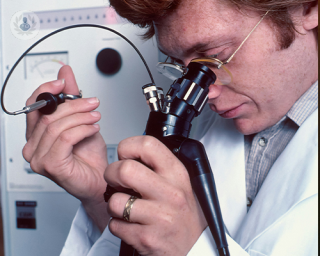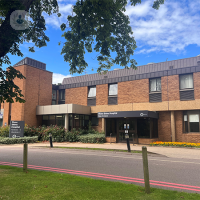What is a bronchoscopy?
A bronchoscopy is a medical procedure performed to visualise the airways and to detect any lung disease. It may also be carried out during treatment for certain lung problems.

What does a bronchoscopy involve?
The device used, called a bronchoscope, is a tube measuring roughly one centimetre in diameter and around 60 centimetres in length. The bronchoscope may be flexible or rigid, but the flexible type is more commonly used. The bronchoscope is inserted through the mouth or nose and is then directed down the trachea and into the lungs. This allows an examination of the upper airways. If the bronchoscope is inserted through the mouth, a larger one can be used.
Why is a bronchoscopy performed?
A bronchoscopy is performed to help diagnose lung problems. The specialist may study the airways or even take a sample for further investigation.
The following is a list of reasons for performing a bronchoscopy:
- To obtain images for studying tumours, lung tissue, or the collapse of an area of the lung.
- To examine the lymph nodes near the lungs.
- To determine why a person is coughing up blood.
- To find the causes of shortness of breath or low oxygen levels.
- To examine the airways to check for any blockages.
- To look for possible infection in the lungs and bronchi.
- To check whether there is a rejection after a lung transplant.
How should I prepare for a bronchoscopy?
The medical examination usually takes around 30 minutes. However, the time will ultimately depend on the specialist. Sometimes, they may take a sample to perform a biopsy, or might come across complications during the procedure.
Depending on the type of bronchoscopy, hospital admission may be necessary, particularly in the case of a rigid bronchoscopy. It is also recommended to go accompanied to the bronchoscopy, since sedation is used and you will need to be accompanied on the way home too. You should also avoid eating or drinking 8 to 10 hours prior to the procedure.
What do you feel during a bronchoscopy?
Initially, and until the local anaesthetic takes effect, you might feel an urge to cough or gag, due to the fluid going down your throat. You might feel pressure or a tugging sensation as the device enters the throat.
You might also experience a sensation of choking or being unable to breathe. However, there is no risk of this happening, as the muscle-relaxing medications will help you feel comfortable. Finally, when the anaesthetic wears off, you might have a scratchy throat for a few days. You must not eat or drink anything immediately after the procedure.
What do abnormal results from a bronchoscopy mean?
The following pathologies can be diagnosed by performing a bronchoscopy:
- Infection caused by bacteria, viruses, fungi, parasites or tuberculosis
- Lung damage caused by allergic reactions
- Lung diseases, where the inner tissues of the lung become inflamed and damaged
- Lung cancer or cancer in the area between the lungs
- Stenosis (narrowing) of the trachea or bronchi, including severe rejection after a lung transplant.
Bronchoscopy
Professor Neal Navani - Pulmonology & respiratory medicine
Created on: 11-13-2012
Updated on: 08-29-2023
Edited by: Conor Lynch
What is a bronchoscopy?
A bronchoscopy is a medical procedure performed to visualise the airways and to detect any lung disease. It may also be carried out during treatment for certain lung problems.

What does a bronchoscopy involve?
The device used, called a bronchoscope, is a tube measuring roughly one centimetre in diameter and around 60 centimetres in length. The bronchoscope may be flexible or rigid, but the flexible type is more commonly used. The bronchoscope is inserted through the mouth or nose and is then directed down the trachea and into the lungs. This allows an examination of the upper airways. If the bronchoscope is inserted through the mouth, a larger one can be used.
Why is a bronchoscopy performed?
A bronchoscopy is performed to help diagnose lung problems. The specialist may study the airways or even take a sample for further investigation.
The following is a list of reasons for performing a bronchoscopy:
- To obtain images for studying tumours, lung tissue, or the collapse of an area of the lung.
- To examine the lymph nodes near the lungs.
- To determine why a person is coughing up blood.
- To find the causes of shortness of breath or low oxygen levels.
- To examine the airways to check for any blockages.
- To look for possible infection in the lungs and bronchi.
- To check whether there is a rejection after a lung transplant.
How should I prepare for a bronchoscopy?
The medical examination usually takes around 30 minutes. However, the time will ultimately depend on the specialist. Sometimes, they may take a sample to perform a biopsy, or might come across complications during the procedure.
Depending on the type of bronchoscopy, hospital admission may be necessary, particularly in the case of a rigid bronchoscopy. It is also recommended to go accompanied to the bronchoscopy, since sedation is used and you will need to be accompanied on the way home too. You should also avoid eating or drinking 8 to 10 hours prior to the procedure.
What do you feel during a bronchoscopy?
Initially, and until the local anaesthetic takes effect, you might feel an urge to cough or gag, due to the fluid going down your throat. You might feel pressure or a tugging sensation as the device enters the throat.
You might also experience a sensation of choking or being unable to breathe. However, there is no risk of this happening, as the muscle-relaxing medications will help you feel comfortable. Finally, when the anaesthetic wears off, you might have a scratchy throat for a few days. You must not eat or drink anything immediately after the procedure.
What do abnormal results from a bronchoscopy mean?
The following pathologies can be diagnosed by performing a bronchoscopy:
- Infection caused by bacteria, viruses, fungi, parasites or tuberculosis
- Lung damage caused by allergic reactions
- Lung diseases, where the inner tissues of the lung become inflamed and damaged
- Lung cancer or cancer in the area between the lungs
- Stenosis (narrowing) of the trachea or bronchi, including severe rejection after a lung transplant.


Bronchoscopy: An expert insight into the procedure
By Dr Bhashkar Mukherjee
2024-12-29
A bronchoscopy is a medical procedure performed by a respiratory physician to examine the inside of the airways and the lungs using a tube called a bronchoscope. Here to provide an expert insight into a bronchoscopy procedure, including indications, risks and benefits, is Dr Bhashkar Mukherjee, leading consultant physician in respiratory and internal medicine. See more


Bronchoscopy: what is its purpose?
By Dr Sundeep Kaul
2024-12-28
Leading expert in respiratory medicine and critical care Dr Sundeep Kaul explains bronchoscopy, including what it is used to diagnose and what happens during the procedure. See more


Bronchoscopy: a lungful
By Mr Kelvin Lau
2024-12-20
A bronchoscopy is a medical exam to view the inside of the airways and lungs, as part of a diagnostic process for pulmonary or respiratory ailments. In this article, a consultant thoracic and cardiothoracic surgeon explains this procedure. See more


Exploring bronchoscopy: A guide to the procedure
By Dr Marcus Pittman
2024-12-15
Bronchoscopy is a medical procedure that allows physicians to examine the airways of the lungs, providing valuable diagnostic and therapeutic insights into respiratory conditions. This minimally invasive technique has revolutionised the field of pulmonology, offering a window into the intricate network of bronchi and bronchioles. In his latest online article, Dr Marcus Pittman delves into the various aspects of bronchoscopy, its applications, procedure, and the significance it holds in the realm of respiratory medicine. See more
Experts in Bronchoscopy
-
Professor Neal Navani
Pulmonology & respiratory medicineExpert in:
- Endobronchial ultrasound
- Lung cancer
- Chronic cough
- Bronchoscopy
- Asthma
- Respiratory diseases
-
Dr Sundeep Kaul
Pulmonology & respiratory medicineExpert in:
- Asthma
- Bronchoscopy
- Chronic cough
- Lung cancer
- Shortness of breath
- Long Covid
-
Mr Kelvin Lau
Cardiothoracic surgeryExpert in:
- Lung cancer
- Chronic obstructive pulmonary disease (COPD)
- Pneumothorax
- Pleural effusion
- Bronchoscopy
- Videothoracoscopy
-
Dr Enson Thomas
Pulmonology & respiratory medicineExpert in:
- Cough
- Sleep disorders
- Lung cancer
- Asthma
- Bronchoscopy
- Endobronchial ultrasound
-
Dr Deepak Rao
Pulmonology & respiratory medicineExpert in:
- Pleural effusion
- Lung cancer
- Bronchoscopy
- Asthma
- Chronic obstructive pulmonary disease (COPD)
- Sleep apnoea
- See all

Three Shires Hospital - part of Circle Health Group
Three Shires Hospital - part of Circle Health Group
The Avenue, Northampton NN1 5DR
No existe teléfono en el centro.
By using the telephone number provided by TOP DOCTORS, you automatically agree to let us use your phone number for statistical and commercial purposes. For further information, read our Privacy Policy
Top Doctors

Cleveland Clinic London Hospital
Cleveland Clinic London Hospital
33 Grosvenor Place
No existe teléfono en el centro.
By using the telephone number provided by TOP DOCTORS, you automatically agree to let us use your phone number for statistical and commercial purposes. For further information, read our Privacy Policy
Top Doctors

OneWelbeck Lung Health
OneWelbeck Lung Health
1 Welbeck St, London, W1G 0AR
No existe teléfono en el centro.
By using the telephone number provided by TOP DOCTORS, you automatically agree to let us use your phone number for statistical and commercial purposes. For further information, read our Privacy Policy
Top Doctors
-
Three Shires Hospital - part of Circle Health Group
The Avenue, Northampton NN1 5DR, NorthamptonExpert in:
- Abdominal ultrasound
- Abdominoplasty
- Acne
- Allergies nose and ears
- Allergy
- Voice disorders
-
Cleveland Clinic London Hospital
33 Grosvenor Place, Central LondonExpert in:
- Cardiology
- Colorectal surgery
- Minimal access surgery (keyhole surgery)
- Gallbladder surgery
- Diagnostic Imaging
- Ultrasound
-
OneWelbeck Lung Health
1 Welbeck St, London, W1G 0AR, W1G Marylebone LondonExpert in:
- Thoracic Surgery
- Diagnostics
- Respiratory diseases
- Breathlessness
- Pulmonology and respiratory medicine
- See all
- Most viewed diseases, medical tests, and treatments
- Snoring
- Autoimmune diseases
- Minimal access surgery (keyhole surgery)
- Aortic aneurysms
- Long Covid
- Medicolegal
- Robotic surgery
- MRI
- Respiratory failure
- Interventional cardiology







